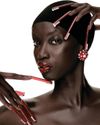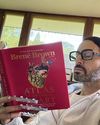
The posters framed it as a fight; a challenge between two heavyweights. At left was Andy Warhol, wearing shiny Everlast boxing gloves, shorts, a black turtleneck, and a vaguely haunted look on his face—he was, by then, a frail 56—his arms crossed like Tutankhamen’. At his side was Jean-Michel Basquiat, shirtless, impassive, and not yet 25, in the same gloves, shorts, and stance. In other imagery, their gloves are raised, or Warhol softly) lands a blow on Basquiat’s jaw. It was 1985, and paintings from a collaboration between the two artists—orchestrated by Swiss art dealer Bruno Bischofberger, who formally introduced them in 1982—were headed to Tony Shafrazi’s gallery on Mercer Street.
The critical response to their project was not warm. When, the year before, paintings that Warhol, Basquiat, and Italian artist Francesco Clemente worked on together were shown in Zurich, Artforum deemed them disappointing...Basquiat’s scribbles, Clemente’s sensuous figures and faces, and Warhol's silkscreen techniques all display visual brilliance, but rarely do they engage in any real dialogue”; and after the Shafrazi show opened in September, The New York Times called its 16 untitled canvases large, bright, messy, full of private jokes and inconclusive.” The insinuation, in the same review, that Basquiat had become a feckless art world mascot” proved especially hurtful; he broke ties with Warhol not long afterward.)
Diese Geschichte stammt aus der November 2022-Ausgabe von Vogue US.
Starten Sie Ihre 7-tägige kostenlose Testversion von Magzter GOLD, um auf Tausende kuratierte Premium-Storys sowie über 8.000 Zeitschriften und Zeitungen zuzugreifen.
Bereits Abonnent ? Anmelden
Diese Geschichte stammt aus der November 2022-Ausgabe von Vogue US.
Starten Sie Ihre 7-tägige kostenlose Testversion von Magzter GOLD, um auf Tausende kuratierte Premium-Storys sowie über 8.000 Zeitschriften und Zeitungen zuzugreifen.
Bereits Abonnent? Anmelden

FINAL CUT
\"WE WANT YOU TO GO FOR IT!\" ANNA TOLD ME

SCREEN TIME
Three films we can't wait to see.

Impossible Beauty
Sometimes, more is more: Surreal lashes and extreme nails put the fierce back in play

Blossoms Dearie
Dynamic, whimsical florals and the humble backdrops of upstate New York make for a charming study in contrasts.

HOME
Six years ago, Marc Jacobs got a call about a house designed by Frank Lloyd Wright. Making it his own, he writes, would be about love, commitment, anxiety, patience, struggle, and, finally, a kind of hard-fought, hard-won peace.

GIRL, INTERRUPTED
Anna Weyant found extraordinary fame as an artist before she had reached her mid-20s. Then came another kind of attention. Dodie Kazanjian meets the painter at the start of a fresh chapter

ROLE PLAY
Kaia Gerber is someone who likes to listen, learn, read books, go to the theater, ask questions, have difficult conversations, act, perform, transform, and stretch herself in everything she does. That she's an object of beauty is almost beside the point.

CALLAS SHEET
Maria Callas's singular voice made her a legend on the stage. In a new film starring Angelina Jolieand on the runwaysthe romance continues.

BOOK IT
A preview of the best fiction coming

GLOBAL VISTAS
Three new exhibitions offer an expansive view.